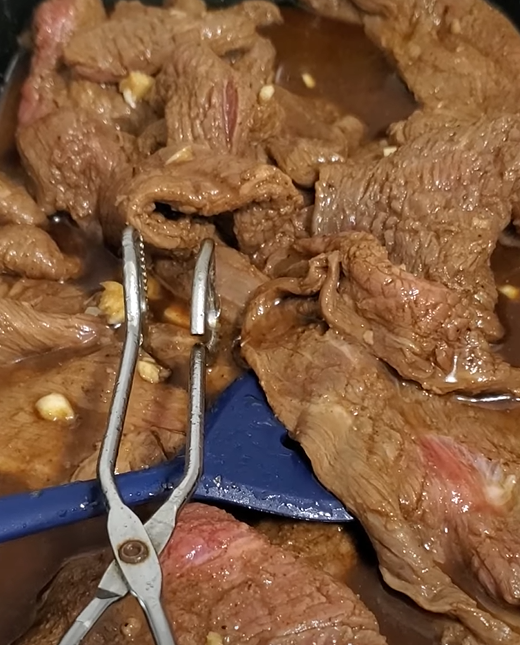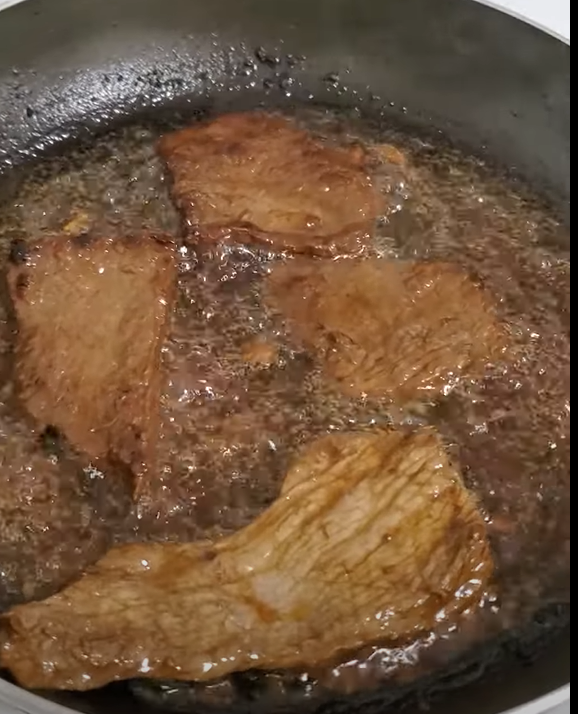When I first encountered Bistek Tagalog at my Filipino friend’s dinner table years ago, I knew I had discovered something truly special. The tender beef swimming in a rich, savory-sweet sauce with perfectly caramelized onions created a symphony of flavors that transported me straight to the heart of Filipino cuisine. Today, I’m excited to share this beloved recipe that has become a staple in my own kitchen.
Bistek Tagalog, literally translating to “Filipino Beefsteak,” represents the beautiful fusion of Spanish colonial influence with indigenous Filipino cooking techniques. This dish embodies the Filipino palate’s love for the perfect balance of salty, sweet, and umami flavors, creating a comfort food that speaks to the soul.
Understanding Bistek Tagalog: More Than Just Beef and Onions
Bistek Tagalog : A traditional Filipino dish consisting of thinly sliced beef marinated and cooked in soy sauce, calamansi juice (or lemon), and topped with caramelized onions.
Calamansi : A small, round citrus fruit native to the Philippines, known for its unique tart-sweet flavor profile that’s essential to authentic Filipino cooking.
Marinade Technique : The process of soaking meat in acidic and flavorful liquids to tenderize and infuse flavor throughout the protein.
The magic of Bistek Tagalog lies not just in its simplicity, but in the careful balance of its core components. Unlike Western beef steaks that rely heavily on the meat’s natural flavor, this Filipino version transforms affordable cuts into something extraordinary through the power of proper marination and cooking technique.
Essential Ingredients for Authentic Bistek Tagalog
Creating the perfect Bistek Tagalog starts with selecting the right ingredients. I’ve learned through years of experimentation that quality matters, but technique matters even more.
Primary Ingredients
| Ingredient | Quantity | Purpose | Substitution Options |
|---|---|---|---|
| Beef Sirloin (thinly sliced) | 2 lbs | Main protein | Chuck roast, ribeye, or tenderloin |
| Large White Onions | 3-4 pieces | Sweetness and texture | Yellow onions (slightly different flavor) |
| Soy Sauce | 1/2 cup | Primary umami and saltiness | Low-sodium soy sauce, tamari |
| Calamansi Juice | 1/4 cup | Acidity and citrus notes | Fresh lemon juice, lime juice |
| Cooking Oil | 3 tablespoons | For frying and sautéing | Vegetable oil, canola oil |
| Black Pepper | 1 teaspoon | Spice and depth | White pepper (milder option) |
| Garlic | 4-5 cloves | Aromatic base | Garlic powder (1 tsp) |
Optional Enhancement Ingredients
| Ingredient | Quantity | Purpose | Notes |
|---|---|---|---|
| Sugar | 1 tablespoon | Balance acidity | Brown sugar adds depth |
| Beef Broth | 1/2 cup | Enhanced meaty flavor | Water works as substitute |
| Bay Leaves | 2 pieces | Aromatic complexity | Remove before serving |
| Fish Sauce | 1 tablespoon | Additional umami | Use sparingly |
The key to exceptional Bistek Tagalog starts with your beef selection. I always choose sirloin for its perfect balance of tenderness and flavor, but I’ve successfully used chuck roast when I want a more economical option. The secret lies in slicing the meat against the grain into thin, uniform pieces – about 1/4 inch thick works perfectly.
My Foolproof Bistek Tagalog Recipe
Through countless iterations and family feedback, I’ve perfected this recipe that consistently delivers restaurant-quality results at home.
Preparation Phase
- Meat Preparation: Slice your beef against the grain into thin strips. This crucial step ensures tenderness regardless of your chosen cut.
- Marinade Creation: In a large bowl, combine soy sauce, calamansi juice (or lemon), minced garlic, and black pepper. This mixture will be your flavor foundation.
- Marination Process: Submerge beef slices in the marinade, ensuring each piece is well-coated. Cover and refrigerate for at least 30 minutes, though I prefer 2-4 hours for maximum flavor penetration.
- Onion Preparation: Slice onions into thick rings – about 1/2 inch thick. These will hold their shape better during cooking and provide that satisfying bite texture.
Cooking Method
Step 1: Onion Caramelization Heat 2 tablespoons of oil in your largest skillet or wok over medium heat. Add sliced onions and cook slowly, stirring occasionally, until they achieve a beautiful golden-brown color. This process takes patience – about 8-10 minutes – but creates the sweet, caramelized flavor that makes this dish special. Remove onions and set aside.
Step 2: Beef Searing Using the same pan (don’t clean it – those browned bits add flavor), increase heat to medium-high. Remove beef from marinade, reserving the liquid. Sear beef slices in batches to avoid overcrowding, about 2-3 minutes per side until nicely browned.
Step 3: Sauce Development Return all beef to the pan and pour in the reserved marinade. Add any optional ingredients like sugar or beef broth at this stage. Bring to a gentle simmer, then reduce heat to low.
Step 4: Final Assembly Allow the beef to simmer in the sauce for 5-7 minutes until the liquid reduces slightly and the meat becomes tender. Return the caramelized onions to the pan, gently folding them into the dish.

Cooking Tips from My Kitchen Experience
Over the years, I’ve discovered several techniques that elevate this dish from good to extraordinary:
Temperature Control: Never rush the cooking process. Medium heat for onions, medium-high for searing, then low for simmering creates the perfect texture progression.
Marinade Timing: While 30 minutes works, marinating overnight transforms the dish completely. The acid breaks down tough fibers while the soy sauce penetrates deep into the meat.
Pan Selection: A wide, heavy-bottomed pan or wok works best. The large surface area allows for proper searing without steaming the meat.
Onion Technique: Don’t stir the onions too frequently during caramelization. Let them develop color naturally for the best flavor development.
Nutritional Profile and Health Benefits
Understanding the nutritional aspects of Bistek Tagalog helps you appreciate why this dish has sustained Filipino families for generations.
Nutritional Breakdown (Per Serving)
| Nutrient | Amount | % Daily Value | Health Benefits |
|---|---|---|---|
| Calories | 385 | 19% | Moderate caloric density |
| Protein | 32g | 64% | Muscle building and repair |
| Carbohydrates | 12g | 4% | Quick energy source |
| Fat | 24g | 37% | Essential fatty acids |
| Iron | 4.2mg | 23% | Blood health support |
| Zinc | 6.8mg | 62% | Immune system support |
| Vitamin B12 | 2.8mcg | 117% | Nervous system health |
| Sodium | 1240mg | 54% | Electrolyte balance |
The high protein content makes Bistek Tagalog an excellent choice for those focusing on muscle development or maintenance. The iron content supports healthy blood production, while the B-vitamins contribute to energy metabolism.
Serving Suggestions and Pairings
My favorite way to serve Bistek Tagalog reflects traditional Filipino dining customs while accommodating modern preferences:
Traditional Pairings:
- Steamed jasmine rice (the classic and most popular choice)
- Garlic fried rice for extra flavor dimension
- Fresh tomato and onion salad for acidic contrast
- Pickled vegetables (atchara) for palate cleansing
Modern Variations:
- Cauliflower rice for low-carb diets
- Quinoa for additional protein and fiber
- Mixed greens salad with light vinaigrette
- Roasted vegetables for added nutrition
Family Style Presentation: I always serve this dish family-style in a large, shallow bowl, allowing everyone to see the beautiful caramelized onions on top. The visual presentation enhances the dining experience significantly.
Regional Variations and Personal Adaptations
Throughout the Philippines, different regions have developed their own interpretations of this classic dish. I’ve incorporated elements from various styles to create my signature version:
Luzon Style: The original version focuses on simplicity – just beef, onions, soy sauce, and calamansi.
Visayan Adaptation: Often includes tomatoes and sometimes bell peppers for additional vegetables and color.
My Personal Touch: I add a small amount of brown sugar and sometimes a splash of beef broth for deeper flavor complexity.
Dietary Modifications I’ve Successfully Tested
Gluten-Free Version: Substitute soy sauce with tamari or coconut aminos. The flavor profile changes slightly but remains delicious.
Lower Sodium Option: Use low-sodium soy sauce and increase calamansi juice slightly to maintain flavor balance.
Protein Alternatives: I’ve successfully made this with pork shoulder, chicken thighs, and even firm tofu for vegetarian friends.
Storage and Reheating Guidelines
Proper storage ensures you can enjoy leftovers without compromising quality:
Storage Instructions
| Method | Duration | Best Practices | Quality Notes |
|---|---|---|---|
| Refrigerator | 3-4 days | Airtight container | Flavors actually improve |
| Freezer | 2-3 months | Portion in freezer bags | Texture slightly changes |
| Room Temperature | 2 hours max | Never leave out longer | Food safety concern |
Reheating Techniques: I prefer reheating in a skillet over low heat with a splash of water or broth. This method preserves the meat’s texture better than microwave reheating. The microwave tends to make the beef tough and rubbery.
Make-Ahead Strategy: This dish actually improves overnight as flavors meld together. I often prepare it the day before serving for special occasions.
Troubleshooting Common Issues
Through years of making this dish, I’ve encountered and solved several common problems:
Problem: Tough, chewy meat Solution: Ensure you’re slicing against the grain and not overcooking. If using tougher cuts, extend marination time and cook at lower temperatures.
Problem: Bland flavor Solution: Increase marination time and don’t be afraid to adjust seasoning during cooking. Taste and adjust soy sauce or calamansi as needed.
Problem: Mushy onions Solution: Add onions back to the pan only in the final minutes. Overcooking destroys their texture and sweetness.
Problem: Too salty Solution: Add a bit more calamansi juice or a small amount of sugar to balance the saltiness.
Questions and Answers
Q: Can I use frozen beef for this recipe? A: Absolutely! I actually prefer using partially frozen beef because it’s easier to slice thinly and uniformly. Just make sure to thaw it completely before marinating, and pat it dry to ensure proper searing.
Q: What’s the best substitute for calamansi juice if I can’t find it? A: Fresh lemon juice works wonderfully and is my go-to substitute. Use the same amount, but you might want to add a tiny pinch of sugar since calamansi is naturally sweeter than lemons. Lime juice works too but creates a slightly different flavor profile.
Q: How thin should I slice the beef? A: I aim for about 1/4 inch thickness. Any thinner and the meat might fall apart during cooking; any thicker and it won’t absorb the marinade flavors properly. The key is consistency – try to make all slices the same thickness for even cooking.
Q: Can I make this dish in advance for meal prep? A: This is actually one of my favorite meal prep dishes! The flavors develop beautifully over time. I prepare it on Sundays and portion it out for the week. It reheats well and tastes even better the next day.
Q: Is there a way to make this dish less salty? A: Yes! Use low-sodium soy sauce and increase the calamansi juice slightly. You can also add more onions, which provide natural sweetness to balance the saltiness. A small amount of sugar also helps balance the flavors.
Q: What cut of beef works best for this recipe? A: Sirloin is my favorite because it’s tender and flavorful, but I’ve had great success with chuck roast (needs longer marination), ribeye (more expensive but incredibly tender), and even flank steak. The key is proper slicing against the grain regardless of the cut you choose.
Q: Can I add vegetables to this dish? A: While traditional Bistek Tagalog focuses on beef and onions, I sometimes add bell peppers or tomatoes. Add them with the onions during the caramelization stage. Just remember that additional vegetables will change the classic flavor profile.
Q: How do I know when the beef is properly cooked? A: The beef should be tender but not mushy, with a rich brown color from the soy sauce. It typically takes 5-7 minutes of simmering after searing. Overcooked beef becomes tough and chewy, so keep an eye on it and taste-test for doneness.
This beloved Filipino dish represents more than just a meal – it’s a connection to culture, family, and the beautiful simplicity of well-balanced flavors. Every time I prepare Bistek Tagalog, I’m reminded of why Filipino cuisine has captured hearts worldwide. The combination of tender beef, sweet caramelized onions, and that perfect salty-citrusy sauce creates comfort food that transcends cultural boundaries.
Whether you’re exploring Filipino cuisine for the first time or reconnecting with childhood flavors, this recipe will deliver authentic taste and satisfying results. I encourage you to make it your own by adjusting seasonings to your preference and sharing it with people you care about. After all, the best recipes are those that bring people together around the table, creating new memories while honoring culinary traditions.


